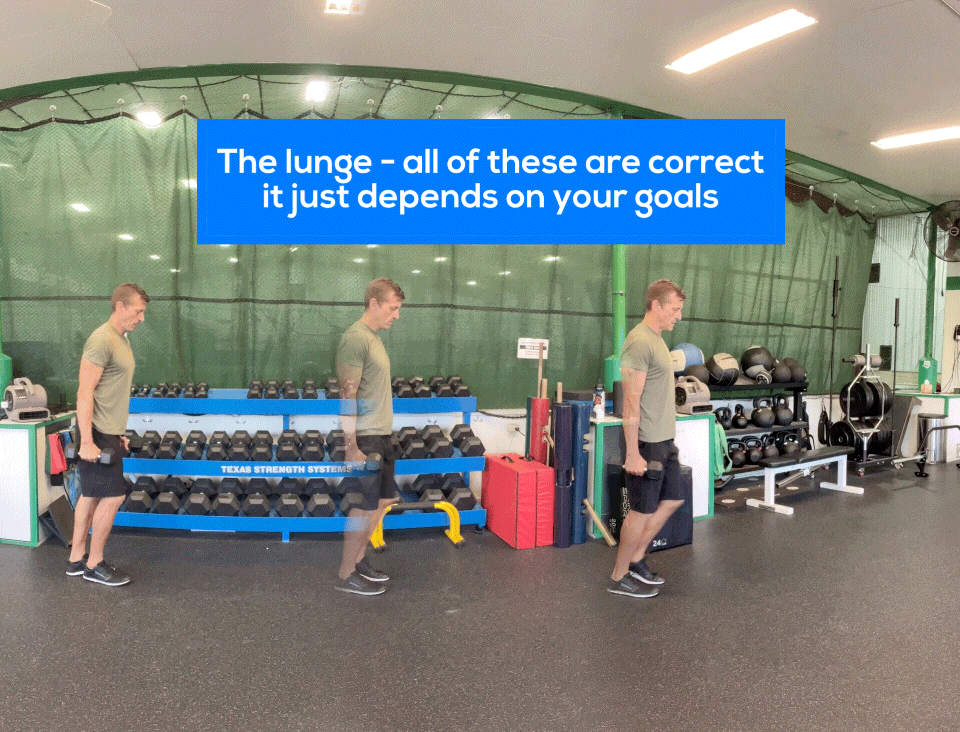Once upon a time, in a galaxy far, far away (okay, it was really just the local gym), there was a golden rule of lunges. Coaches and trainers all chanted in unison, "Never let thy knee travel past thy toes!" This well-intentioned but overly cautious dictum was meant to protect our precious knee joints from the horrifying beast known as injury (1).
However, as Bob Dylan crooned, "The times they are a-changin'", and so is our understanding of knee positioning in lunges. So, grab your workout gear, folks, because we're about to journey through the evolution of knee position and how a little knee wobble can change which muscles scream for mercy.
The Old Guard: Knee Behind the Toes
The knee-behind-the-toes rule was originally meant to keep us safe (1). It's like the cautionary advice from grandma: "Don't run with scissors, dear!" The idea was to reduce the stress on the knee joint and ligaments, so lunges were performed with an upright torso, and a step that was long enough to cross a small river, all to ensure this alignment (2). But, like many outdated practices (looking at you, leech therapy), this approach has been reconsidered.
Rebellion Against Tradition: The Knee’s Journey Over the Toes
cience, the ultimate party pooper, decided to put the traditional belief to the test. Lo and behold, it turned out that it's not only natural for the knee to travel past the toes in many movements, but it could also be beneficial (3). Researchers found that limiting forward knee movement can actually increase stress on the hip and lower back (3). In other words, by trying to protect the knees, we were unwittingly throwing the hips and back under the bus.
Allowing the knee to travel over the toes was found to increase the work done by the quadriceps, the muscles that, when sculpted, make your legs look like they belong on a Greek statue (3).

The Knee Position Shuffle: Choose Your Own Adventure
Knee positioning during lunges can be like adjusting the settings on your favorite video game: each change affects your character's performance differently.
- Knee behind the toes: This is like setting your game to 'easy' mode. It's a safer bet for your knees and allows your glutes and hamstrings to steal the limelight from your quads (4). The quads are still involved but aren't the main act.
- Knee over the toes: This is like setting the game to 'hard' mode, particularly for the quadriceps. They'll be feeling the burn, but hey, no pain, no gain, right? This position is like a virtual reality simulation of climbing stairs or sprinting and is excellent for athletes looking to ramp up their game (3).
- Knee in line with the toes: Consider this the 'balanced' mode. A more harmonious workout, it splits the workload pretty evenly between your quadriceps and your glutes/hamstrings (5).
The Last Laugh
It turns out the knee position over the foot during lunges isn't as cut-and-dry as we thought. It's a variable to play around with, depending on your goals, fitness level, and whether you like the feeling of jelly legs after a workout.
But remember, folks, proper lunge form isn't all about the knee. A steady core, a straight back, and correct foot alignment are equally important. If your knees are creaky or cranky, make sure to have a chat with your healthcare or fitness professional before you start experimenting with your form (6).
As we continue to chuckle and lunge our way through the ever-evolving world of exercise science, one thing is certain: our understanding of the body's mechanics and exercise practices will become more nuanced, allowing for safer, more effective, and yes, more entertaining workouts.
References:
- Escamilla RF, Zheng N, MacLeod TD, Edwards WB, Imamura R, Hreljac A, Fleisig GS, Wilk KE, Moorman CT, Andrews JR. Cruciate ligament tensile forces during the forward and side lunge. Clin Biomech (Bristol, Avon). 2010;25(3):213-221.
- Fry AC, Smith JC, Schilling BK. Effect of knee position on hip and knee torques during the barbell squat. J Strength Cond Res. 2003;17(4):629-633.
- Bowersock CD, Willy RW, DeVita P, Willson JD. Independent effects of step length and foot strike pattern on tibiofemoral joint forces during running. J Sports Sci. 2017;35(20):2005-2013.
- Gullett JC, Tillman MD, Gutierrez GM, Chow JW. A biomechanical comparison of back and front squats in healthy trained individuals. J Strength Cond Res. 2009;23(1):284-292.
- Decker MJ, Torry MR, Wyland DJ, Sterett WI, Richard Steadman J. Gender differences in lower extremity kinematics, kinetics and energy absorption during landing. Clin Biomech (Bristol, Avon). 2003;18(7):662-669.
- Blackburn JT, Padua DA. Sagittal-plane trunk position, landing forces, and quadriceps electromyographic activity. J Athl Train. 2009;44(2):174-179.

